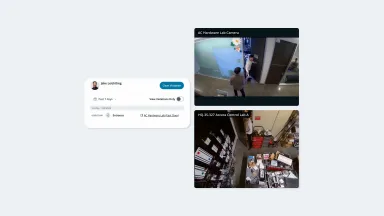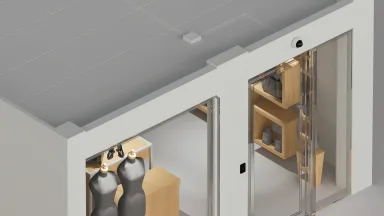Verkada access controllers and cameras feature powerful edge-based computing and processing capabilities that underpin our bandwidth friendly, security-focused solution.
In this post, we explore how peer-to-peer (P2P) device communication, Verkada's latest hybrid cloud engineering effort, enables a new way for devices within our ecosystem to communicate more securely with other devices without always having to broker communications through a central cloud server.
P2P is a powerful development because it allows devices to have a shared understanding of the network of devices around them through a protected process that requires minimal end user effort to configure. With the Verkada cloud as the central brokering server, organizations can create a secure network connection between Verkada devices in a way that is fast, reliable, and entirely based on the local network.
Discovery, Authentication, and Connection
With P2P device communications, Verkada P2P-enabled devices communicate device-to-cloud and then device-to-device, using the Verkada platform as a central server. Communicating in this way allows devices to establish a more secure connection than would be otherwise possible.
When a user configures a feature that requires P2P communication, devices will automatically connect with each other by signing a trusted and secure encryption certificate. Once connected, devices have a secure data channel that allows them to subscribe to cross-device events. This communication is serverless and takes place entirely on the local network.
Because the Verkada cloud platform brokers this handshake, both devices know that the communications are legitimate and are being established between Verkada devices — reducing the threat of snooping or impersonation. Verkada devices can even request updated certificates to reestablish the connection anytime.
One-Click Device Integration
P2P-enabled features like LPR unlock and configurable AUX outputs are easily configured directly from Command. LPR unlock utilizes the license plate recognition capabilities of Verkada CB52 and CB62 cameras to recognize license plates and uses P2P to broker a connection to Verkada door controllers, which will make access decisions with the license plate information.
To set up LPR unlock, customers simply enable license plate analytics and LPR unlock and then add license plates as access user credentials from the LPR camera feed page or the access user profile page. You can see a full integration breakdown of LPR unlock in the Integration Guide.
Enhanced Reliability
P2P-enabled features work in parallel with cloud-brokered cross-device communications. Running both services in parallel helps deliver the best of both worlds: devices can communicate through the cloud for centralized visibility and management while, at the same time, communicating peer-to-peer for faster communication speeds and reliable device connection regardless of internet status.
To give our users a clear understanding of how devices communicate with each other and any issues that may have come up, we’ve built connection status indicators right into Command. Command users can now easily see any P2P-enabled devices and the status of both the cloud and P2P connection. This is particularly valuable when a system loses its internet connection: Command will clearly communicate that devices were last seen as connected, providing the knowledge that systems are likely still functional even if they are not available for real-time review and management via Command.
Beyond LPR Unlock
In addition to powering LPR unlock, P2P also enables Verkada controllers to subscribe to events on other controllers in the same Command organization through cross-device AUX outputs. With cross-device AUX outputs, auxiliary devices can be activated and deactivated from an input signal from any Verkada Controller - not just the controller the device is connected to. Controllers on the same local network can, for example, subscribe to all emergency exit door position indicators events to automatically trigger buzzers or lights across multiple controllers in response to any emergency door being opened.
P2P creates a simple authentication and communications protocol across devices while maintaining a more secure connection without any further input or maintenance. This exciting new communication capability enables fast, and reliable communication, regardless of Internet connectivity or network configurations.
Reliable and Built With Security in Mind
P2P is a great example of how Verkada constantly drives towards higher standards for device reliability, security, and privacy. This focus simplifies configurations and reduces security risks that are all too common with IoT devices.
P2P is a game changer for features that depend on reliable, real-time communications between devices, and we look forward to continuing to roll out this cross-device capability to more devices and features.





